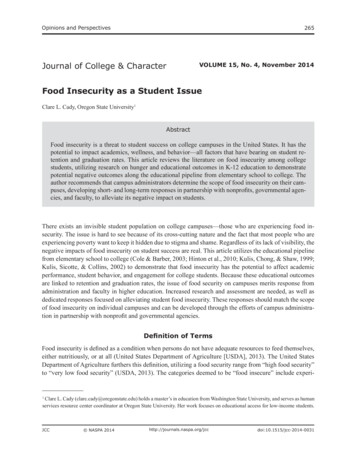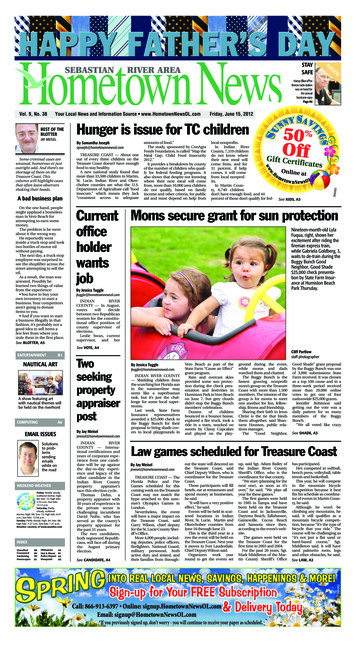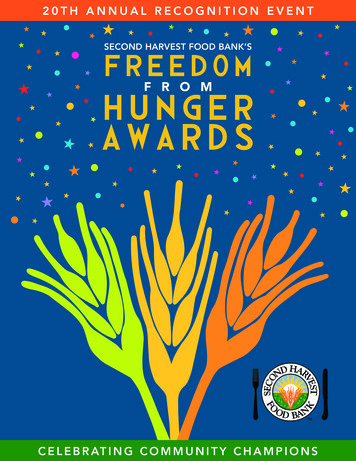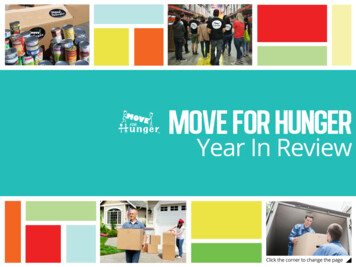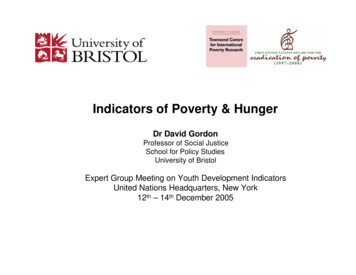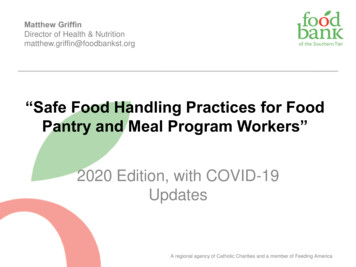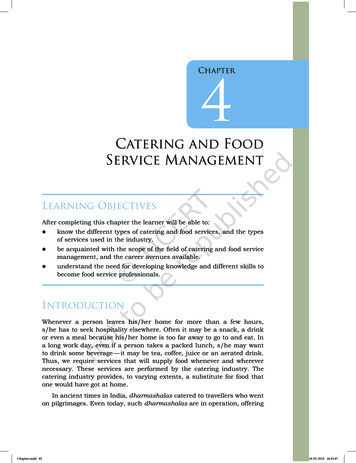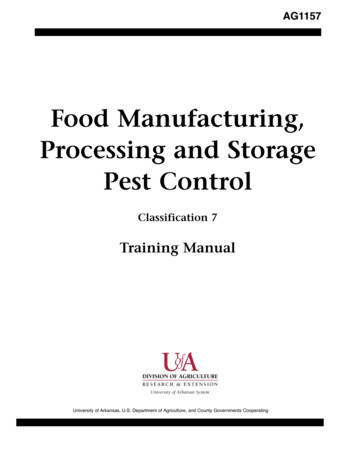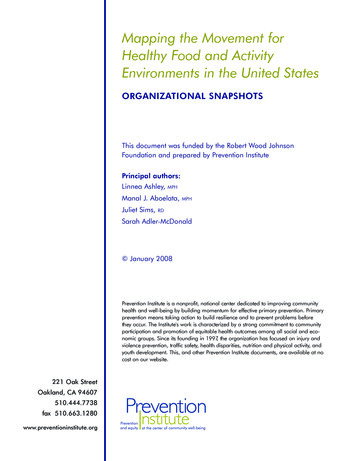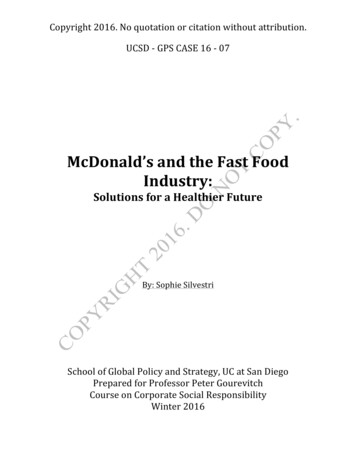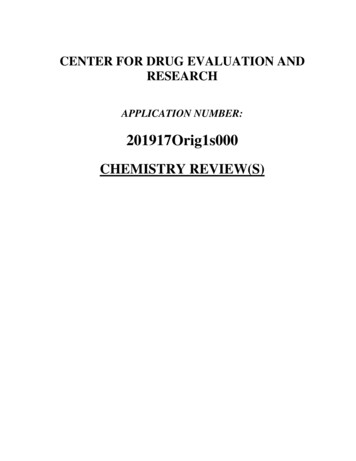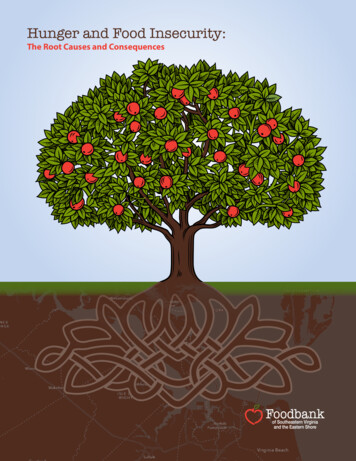
Transcription
Hunger and Food Insecurity:The Root Causes and ConsequencesHunger and Food Insecurity: Root Causes and Consequences1
TOGETHER WE CAN.Armada Hoffler Properties is a proud sponsor ofThe Foodbank of Southeastern Virginia and the Eastern Shore.2Hunger and Food Insecurity: Root Causes and ConsequencesDEVELOPMENT CONSTRUCTION ASSET MANGEMENTARMADAHOFFLER.COM
Dear Foodbank Partners,In 1980, when a small group of individuals from the SoutheasternTidewater Opportunity Project (STOP, Inc.) of Hampton Roads cametogether to start the Community Food and Nutrition Program,it is unlikely that they knew how the program would grow. Justone year after seeds of hope were planted, that program becamea nonprofit organization and one of Virginia’s first food banks.Ruth Jones Nichols, Ph.D.President & ChiefExecutive OfficerKevin X. JonesChair of the Board of DirectorsTable ofContentsHunger, Food Insecurity andthe Meal Gap.4Mapping Food Insecurity.5Federal Legislation ThatImpacts Our Work.6The Benefits Cliff.7Profiles of Hope andPerseverance.8Exploring the Root Causesof Hunger and FoodInsecurity.16The Root Causes of FoodInsecurity.27What started as a program to serve the hungry has maturedinto what is now the Foodbank of Southeastern Virginia and theEastern Shore. Our organization has grown from distributingapproximately 400,000 pounds of food in its first year to distributingclose to 18 million pounds of food each year since 2016. We takegreat pride in the accomplishment of distributing more than 300million meals through our robust network of partner agenciesand programs since incorporating in 1981. We recognize, as well,the need for our work to evolve and more holistically address theroot causes and consequences of hunger and food insecurity.In this report, “Hunger and Food Insecurity: The Root Causes andConsequences,” we offer a glimpse of the complex factors guidingthe evolution of our work. We begin by articulating the differencebetween hunger and food insecurity, as well as highlightingthe number of meals missing from the tables of our neighborswho struggle to meet their most basic needs. We also provideseveral illustrations to show the manner in which hunger andfood insecurity intersect with other population-level variablessuch as income, race/ethnicity and homeownership status.Further, we offer an overview of federal legislation impactingour work to provide a framework for understanding “the cliffeffect” that occurs when individuals make earnest attempts tomove from poverty to self-sufficiency. We present four profilesof individuals who have experienced hunger and food insecurityto help underscore the various circumstances connected to rootcauses and consequences. Finally, we conclude with findings froma research study conducted in early 2019 to explore individualand systems-level root causes of hunger and food insecurity.As we continue to evolve, we remain steadfast in ourcommitment to achieving the ambitious vision for a hungerfree community. We will continue to provide healthy,nutritious food for individuals struggling with hunger andbegin to broker collaborative partnerships that leveragefood in programs offering access to employment, highereducation, housing, healthcare and financial literacy.Thank you, in advance, for supporting our growth and journey.Hunger and Food Insecurity: Root Causes and Consequences3
Hunger, Food Insecurity and The Meal GapHunger—a feeling of discomfort or weakness caused by lack of food, coupled withthe desire to eat.Food insecurity—a lack of access, at times, to enough food for an active, healthylife for all members of a given household, and limited or uncertain availability ofnutritionally adequate foods.The Meal Gap—the number of meals still missing after the Foodbank and ourhunger-relief partners provide meals to plates that would have otherwise been empty.LocalityNumber ofEstimatedFood-InsecureNumber ofIndividuals Meals MissingNumberof MealsProvided bythe FoodbankPercent ofMeal GapClosedNumber ofMeals StillMissing 80286,928289,990101%0Isle of 444,3043,109,67042%4,334,634Data Sources1. Feeding America Map the Meal Gap 2017 Overall County Food Insecurity in Virginia2. MPIN County-Level Compliance Indicator Report for the four quarter period ending Q2 20194Hunger and Food Insecurity: Root Causes and Consequences
Mapping Food InsecurityThe Foodbank of Southeastern Virginia and the Eastern Shore conducted extensive mapping in 2018to identify which communities had high rates of food insecurity as well as low access to grocery storesand to layer our partners and programs over each community. This ongoing analysis highlights whichcommunities need greater resources and creative partnerships to meet the needs of our neighborsexperiencing food insecurity.These maps highlight population-level statistics in two urban and rural communities within our servicearea, one in Norfolk and one in Western Tidewater—including Franklin, Southampton County and Isleof Wight County— where food insecurity disparities are most severe. These neighborhoods representthe wide range of food insecurity rates in our community, even in areas that are adjacent to oneanother, illustrating our reason for not only “feeding the line” but “ending the line.”RailroadTracks21st and Colonial Ave.eRd.eAnnFood Insecurity Rate: 8%# of Food Insecure Individuals: 94Poverty Rate: 4%Unemployment Rate: 3%Median Income: 100,865% African American: 4%% Hispanic: 2%% Home Owners: 57%E. Brambleton Ave.St.Ghent SquareChurchlo AvenuincessMonticelW.PrScale: 1” .35 milesFood Insecurity Rate: 17%# of Food Insecure Individuals: 234Poverty Rate: 8%Unemployment Rate: 8%Median Income: 53,550% African American: 15%% Hispanic: 5%% Home Owners: 26%Young TerraceFood Insecurity Rate: 57%# of Food Insecure Individuals: 1,079Poverty Rate: 73%Unemployment Rate: 38%Median Income: 11,691% African American: 94%E. Virgi% Hispanic: 5%niaBea% Home Owners: 2%chIsle of Wight*Blvd.Food Insecurity Rate: 14%# of Food Insecure Individuals: 591Poverty Rate: 13%Unemployment Rate: 9%Median Income: 60,417% African American: 30%% Hispanic: 1%% Home Owners: 86%Southampton County**The numbers for Isle of Wight andSouthampton County representcensus tracts adjacent to the Cityof Franklin and not population datafor each entire county.Food Insecurity Rate: 16%# of Food Insecure Individuals: 976Poverty Rate: 16%Unemployment Rate: 6%Median Income: 50,517% African American: 38%% Hispanic: 1%% Home Owners: 73%Hunger and Food Insecurity: Root Causes and ConsequencesFranklinFood Insecurity Rate: 20.2%# of Food Insecure Individuals: 1,680Poverty Rate: 17%Unemployment Rate: 15%Median Income: 38,760% African American: 59%% Hispanic: 1%% Home Owners: 49%5
Federal Legislation that Impacts Our Work andAffects Those We ServeThe Farm BillThe Child NutritionReauthorization ActImpacts access to nutritious food for millions of Americanfamilies struggling with hunger.Helps low-income children at different ages and in differentsettings to reduce hunger and promote nutrition.The Supplemental NutritionFood Program (SNAP)Child and Adult Care FoodProgram (CACFP)The Emergency FoodAssistance Program (TEFAP)National School LunchProgram (NSLP)Commodity SupplementalFood Program (CSFP)The School BreakfastProgram (SBP)Food Donation/RescueThe Summer Food ServiceProgram (SFSP)OTHER PUBLIC ASSISTANCE PROGRAMSPeople who are food insecure often rely onother public assistance programs to help“level the playing field” and move themcloser to the self sufficiency line.6Special Supplemental NutritionProgram for Women, Infants,and Children (WIC)TEMPORARY ASSISTANCE FOR NEEDYFAMILIES (TANF)The TANF program, which is time limited, assistsfamilies with children when parents or otherresponsible relatives cannot provide for thefamily's basic needs.MEDICAID AND CHILDREN’S HEALTHINSURANCE PROGRAM (CHIP)Medicaid provides health coverage to millions ofAmericans, including eligible low-income adults,children, pregnant women, elderly adults andpeople with disabilities. CHIP provides low-costhealth coverage to children in families that earntoo much money to qualify for Medicaid.PUBLIC HOUSING AND HOUSING CHOICEVOUCHERS (SECTION 8)Public housing was established to provide decentand safe rental housing for eligible low-incomefamilies, the elderly and persons with disabilities.CHILD CARE ASSISTANCEIn Virginia, the Child Care Subsidy Programprovides financial assistance to eligible familiesto help pay for the cost of child care so they canwork or attend education or training programs.Hunger and Food Insecurity: Root Causes and Consequences
The “Benefits Cliff”Low-income families often qualify for benefits created by federal legislation that help to cover the costof basic necessities, such as housing assistance, SNAP (food stamps) and subsidized child care. The"Cliff Effect" occurs when families begin to lose benefits as their earnings increase. Oftentimes, the lossin benefits equates to significantly more than the increase in earnings. The result is that families earnmore without improving their financial situation, which impacts their ability to become and remainself-sufficient. The self-sufficiency line refers to the amount of income necessary to meet basic needswithout public subsidies.Congratulations, Olivia!Olivia earns 12.50per hour and works40 hours per week.This brings herannual income to 26,000. A livingwage in her Virginiacity is more thantwice her salary( 31.10 perhour/ 64,688annually), butwith the benefitsthat Olivia receives,her income climbsto 1,880 above the selfsufficiency line.Meet Olivia,a schoolreceptionistand singlemother of twoyoung children.Olivia is a trailblazer.Two years later, sheis promoted tosuperintendent’ssecretarywith a newannual salaryof 45,000.This new salaryrenders Oliviaineligible for nearlyall of the benefits thatshe had been receiving.Although she hasmade great careeraccomplishments,she once again slides 4,286 below the selfsufficiency line. She is promoted to schoolsecretary with a higher payrate of 14.50 per hour. Stillworking 40 hours per week,her new annual income is 30,160. However, this 4,160annual raise makes Oliviaineligible for 7,440 inbenefits that she waspreviously receiving.This causes her to slidedown to 1,400below the selfsufficiency line.After taking the timeneeded to heal, Oliviareturns to full-timework the followingschool year. Herexcellent work ethicpaid off and she waspromoted to officemanager. Herannual income isnow 35,000. Her payincrease was moresubstantial than thebenefits she lostthis time, and Oliviahas once again climbedto 2,000 above the selfsufficiency line.Olivia hasa medicalemergencythat causes herto temporarily limither work time to 25hours per week while she heals.Maintaining her hourly pay rate,Olivia becomes eligible for thepreviously lost benefits. She is alsonow eligible for new temporarybenefits until she returns towork. Now only 270 below theself-sufficiency line, Olivia hasclimbed closer to her goals.Hunger and Food Insecurity: Root Causes and Consequences7
Profiles of Hope and Perseverance – MarquittaLike many parents, Marquittagets creative in the kitchen in order to sneak morevegetables into her kids’ meals. “If I do spaghetti,instead of doing pasta, I’ll take California blendvegetables, put that on the bottom, and I makemy sauce with meat and put that on top withcheese,” she explains. This way she ensures hertwo daughters are eating healthy foods likecauliflower, broccoli and carrots while concealingthe healthy flavors that kids sometimes refuse.Still, with two growing girls in thehouse, it’s challenging to make healthymeals last as long. “I try to improvisewith it and try to stretch,” she says.Marquitta has become well versed at improvisingwhen it comes to meals. Part of this stems fromher culinary background as a professional chef.The other part comes from her experience ofbeing homeless on and off since age 17.Throughout her life, she has worked toovercome challenges. A decade ago when herolder daughter was 2 years old and Marquittawas pregnant with her second child, herhusband passed away expectantly. Downto one income, she struggled financially,veering in and out of homelessness asshe raised her two daughters alone.8Hunger and Food Insecurity: Root Causes and Consequences
“I couldn’t get two jobs because I didn’t havesomebody to watch the kids,” she shares. “Iwould leave them at daycare until 6 because Iknew that they’d get lights and water and beable to eat something.” Once she picked hergirls up, she would drive them to a public park,driveway or other safe location to sleep in theircar. “I would stay up all night to watch my kidssleep because they were scared,” she remembers.“We had to take showers in strangers’houses. My kids have been through a lot.”Lacking a stable support system, her familyhas relied on services from the Foodbank ofSoutheastern Virginia and the Eastern Shore, aswell as other partner organizations to get by,although it’s never quite been enough. “Inside Iwanted to cry,” she says. “As a parent, you’ll starveyourself to feed your children. Being that youknow it’s not enough, I had to train my kids toeat smaller portions, and I still do it now. Whenyou don’t have enough, you just have to adjust.”Eventually, Marquitta qualified for SNAP(Supplemental Nutrition Assistance Program)benefits, but even when she was working andreceiving these benefits, she still struggled tomake ends meet. “That’s when I started goingto the unhealthy stuff,” she recalls. “Noodlesand ravioli—it’s just cheaper to eat poorly.”In 2017, she connected with ForKids and wasplaced in the organization’s fast track programfor housing, which allowed her to move intopublic housing at a rent she could afford.Things were finally starting to look up.However, later that year, she was involvedin a car accident, which resulted in bothher legs being broken and her neck beingfractured. “I couldn’t work,” she says. “Iwent from paying regular rent, doing formyself to, ‘I can’t do anything for myself.’”Now two years later, Marquitta is stillwaiting to learn if she will qualify fordisability. In the meantime, she’s takingaction into her own hands by empoweringothers and furthering her education.Having lived in Norfolk’s Tidewater Gardenscommunity for just a year, she serves as presidentof the Tidewater Gardens Tenant ManagementCouncil where she oversees the organizationand assists residents with their needs, whetherit’s providing information on jobs or connectingthem with resources. She was elected byindividuals in her community because she’scome to be viewed as a person they can trust.Marquitta is also pursuing a professionalcommunications degree at TidewaterCommunity College, which she hopes to utilizein a role of life coaching or public speaking.“I empower and I talk to people every day,giving advice or challenging people” she says.Today, even though her daughters have stablehousing, Marquitta wishes that she could givethem a better life—a life where they’re notexposed to bullying or the sound of gunshotsin their neighborhood. “They’re my motivationfor better; it’s not about me,” she says. “I want toset them up and leave a legacy for them. I don’twant them to remember that we struggled.”Marquitta realizes that it takes a lot of effort tobreak something as steadfast as generationalpoverty, but she’s committed to sparking change.“We relive cycles; I want to cut the cycles,”she asserts. “That takes sacrifice from me.”Hunger and Food Insecurity: Root Causes and Consequences9
Profiles of Hope and Perseverance – ShayMoving to a new,unfamiliar area and starting over completely interms of professional contacts, resources andjob searches can be stressful for anyone. Shayknows this challenge first-hand. Having movedto the region four months ago with her husband,10she has struggled to find a decent-payingjob to help support their new twin babies.Experiencing a double blessing with their twinsmeans double the expenses. “Formula cost isa big one,” she says, adding that diapers areHunger and Food Insecurity: Root Causes and Consequences
another substantialexpense. Theirfamily qualifiesfor WIC benefits,which cover about70 percent of theirgrocery needs.“But the rest—it’slike we’re stillbuying a month’sworth of formulabecause that onlylasts a coupleweeks,” she says.Adding to theburden is the factthat they can’tafford childcare, soShay is only able towork at her parttime job when herhusband can carefor the twins. “I can’twork as much asI want to, and wehave bills to pay,we have to makesure we have waterand electricity,” sheexplains. “When he’shome, we dependon each other.”Unfortunately, her husband isn’t homea lot. He is serving his sixth year in theNavy and is deployed often. “He comesand he goes for weeks,” she says.Shay understands that there is a misconceptionthat military families are automaticallyfinancially stable. “We make just enoughto pay our bills,” she says. “We stay in thehouse all day every day because we don’thave money to take the kids to the zoo orsomewhere. We don’t have that fluidity.”Because her husband serves in the military,Shay doesn’t always feel comfortable disclosingtheir family’s situation to others, including othermilitary spouses. “It’s hard to express to the Fleet& Family—we’re really struggling. We need help.”Shay’s situation isn’t rare. One in fivehouseholds served by the Feeding Americanetwork includes a member that has servedin the US military. In Virginia, an estimated21 percent of households served by Virginiafood banks report that someone in theirhousehold has served or is currently servingin the U.S. Armed Forces or as a member ofthe military Reserve or National Guard.Like many military families, Shay describescertain obstacles that her family has had tonavigate. For example, the money that herhusband receives from a basic allowance forhousing (BAH) is enough to cover the rent but noadditional utilities, which leaves them financiallystrapped when it comes to providing all theother basic necessities for a family of four.When money has gotten especially tight, Shayhas come to the Foodbank of SoutheasternVirginia and the Eastern Shore for assistance,receiving necessities like diapers, wipes andformula. The Foodbank has also provided herwith information to apply for online jobs, whichcould bring in extra finances when she’s unableto leave the house, and SNAP (SupplementalNutrition Assistance Program) benefits, whichwould assist in their grocery expenses. “It’shelped,” Shay says. “Knowing that there areresources that I can take advantage of.”As for Shay’s future, she looks forward to atime when she can secure a better payingjob, when her family can afford childcare andwhen they can live life to the fullest with theirdouble blessings. But for now, figuring out thebasic necessities is her biggest concern. “I justwant my kids to be safe,” she says. “I want toensure that they have food in their mouths.”Hunger and Food Insecurity: Root Causes and Consequences11
SProfiles of Hope and Perseverance – Jodiixty-four-year-old Jodi sitsquietly in her living room on Virginia’s EasternShore, her hands steadily at work as she sews anoutfit for a stuffed pig. “I sewed the pig first, andnow I’m making it an outfit,” she says cheerfully.Most of her days are spent this way—sewing,12reading or watching her favorite TV shows. “I tryto keep my mind occupied,” she says. “And I’
to 1,880 above the self-sufficiency line. She is promoted to school secretary with a higher pay rate of 14.50 per hour. Still working 40 hours per week, her new annual income is 30,160. However, this 4,160 annual raise makes Olivia ineligible for 7,440 in benefits that she was prev
